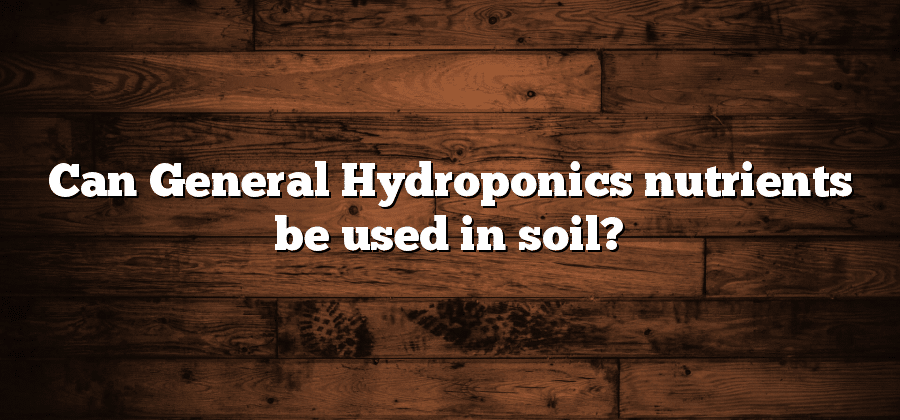Benefits of General Hydroponics Nutrients
General Hydroponics nutrients offer numerous benefits for growers looking to maximize the potential of their plants. One of the key advantages is the ability to provide plants with a precise and balanced mix of essential nutrients. Unlike traditional soil-based growing methods, where nutrient levels can vary and be difficult to control, General Hydroponics nutrients allow growers to customize the nutrient solution to meet the specific needs of their plants. This ensures that plants receive the optimal balance of nutrients, enhancing their growth, development, and overall health.
Another significant benefit of using General Hydroponics nutrients is the increased efficiency and effectiveness of nutrient uptake by plants. With hydroponics, the nutrients are delivered directly to the plant’s root system in a readily available form. This eliminates the need for plants to expend energy searching for nutrients in the soil, allowing them to allocate more energy towards growth and production. Additionally, the controlled environment of hydroponics systems helps to reduce the risk of nutrient deficiencies or imbalances, ensuring plants can reach their full potential.
Appropriate Nutrient Ratios for Soil
In order to maximize plant growth and ensure healthy soil conditions, it is crucial to maintain appropriate nutrient ratios. These ratios refer to the ideal balance of essential nutrients that plants need for optimal growth and development. Failure to maintain the correct nutrient ratios can lead to nutrient deficiencies or imbalances, which can result in stunted growth, poor fruit or flower production, and increased susceptibility to pests and diseases.
The appropriate nutrient ratios for soil depend on several factors, including the specific requirements of the plants being grown, the type of soil present, and the overall nutrient composition of the soil. Generally, the main nutrients that plants require in larger quantities are nitrogen (N), phosphorus (P), and potassium (K), often referred to as NPK. However, it is important to note that plants also require smaller amounts of secondary and micronutrients, such as calcium, magnesium, iron, and zinc, among others. Achieving the right balance of these nutrients is essential for promoting healthy plant growth and ensuring optimum nutrient uptake.
Understanding Soil Nutrient Requirements
Soil nutrient requirements play a crucial role in the overall health and productivity of plants. Each type of soil has its own unique set of nutrient requirements, which are determined by factors such as soil composition, pH levels, and the specific needs of the plants being grown. Understanding these requirements is essential for achieving optimal plant growth and maximizing yields.
One of the key aspects of understanding soil nutrient requirements is acknowledging the different types of nutrients that are needed for plant growth. These nutrients can be classified into two categories: macronutrients and micronutrients. Macronutrients, such as nitrogen, phosphorus, and potassium, are required in larger quantities, while micronutrients, including iron, zinc, and manganese, are needed in smaller amounts. It is important to strike the right balance of these nutrients to ensure that plants have all the necessary elements for proper growth and development.
Compatibility of General Hydroponics Nutrients with Soil
General Hydroponics Nutrients have gained popularity among hydroponic growers due to their effectiveness in stimulating plant growth and development. However, many gardeners wonder if these nutrients can also be used in soil-based gardening. The short answer is yes, but it is essential to understand the compatibility of General Hydroponics Nutrients with soil and the appropriate application methods.
When using General Hydroponics Nutrients in soil, it’s crucial to consider the nutrient ratios. Soil has different nutrient requirements compared to hydroponic systems. Therefore, it’s recommended to adjust the nutrient ratios accordingly to meet the specific needs of the plants. Conducting a soil test can provide valuable information on the existing nutrient levels and help determine the appropriate adjustments to ensure optimal growth.
Another critical factor to consider is the application method. While General Hydroponics Nutrients are specifically designed for hydroponic systems, they can still be applied to soil-based gardens. However, it is important to follow the recommended application rates and dilution ratios to prevent nutrient imbalance and potential plant damage. Mixing the nutrients with water and applying them around the base of the plants is a common method in soil-based gardening.
Optimal Application Methods for Soil
Proper application methods are crucial when using General Hydroponics Nutrients in soil-based gardening. The goal is to ensure that the nutrients are applied efficiently and effectively to support plant growth and development.
One effective method for applying General Hydroponics Nutrients to soil is through the process of top-dressing. This involves applying the nutrients directly to the surface of the soil and gently working them in with a rake or hand tool. This method allows for even distribution of the nutrients throughout the soil, promoting balanced nutrient uptake by the plants. It is important to follow the recommended dosage guidelines provided by General Hydroponics to avoid over-application, which could cause nutrient imbalances and potential harm to the plants.
Another recommended method for applying General Hydroponics Nutrients to soil is through the use of drip irrigation systems. This method ensures a controlled release of nutrients directly to the root zone of the plants. By utilizing a drip system, the nutrients are delivered in a consistent and targeted manner, promoting optimal absorption by the plants. It is essential to properly calibrate the irrigation system to deliver the correct amount of nutrients based on the specific needs of the plants and the soil composition. Monitoring the moisture levels in the soil can also help in determining the frequency and duration of nutrient application through drip irrigation.
Both top-dressing and drip irrigation are effective application methods for using General Hydroponics Nutrients in soil-based gardening. However, it is important to consider the unique needs of the plants, the soil conditions, and the specific General Hydroponics Nutrients being used. Consulting with professional horticulturists or referring to the product instructions can provide further guidance on the best optimal application methods for soil.






